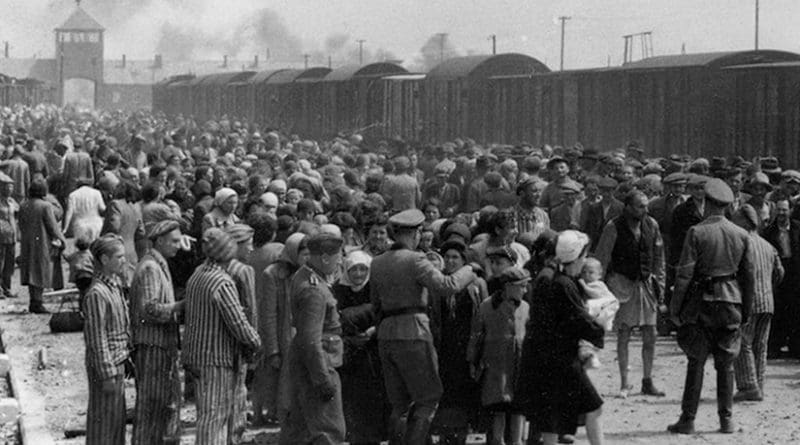Remember The Holocaust So Its Horrors Aren’t Repeated – OpEd
By Arab News
By Ellen R. Wald*
Sometimes it appears as though hate and bigotry are overwhelming societies across the globe. This past weekend, there was another deadly shooting at a synagogue in the US and an anti-Semitic cartoon printed in the international edition of the New York Times. Last week, terrorists killed 250 people in attacks largely targeting Christians in Sri Lanka. In March, 50 Muslims were killed during Friday prayers in New Zealand. At about the same time, 280 Nigerians were murdered because they were Christian.
We recently marked 104 years since the Ottomans began the Armenian genocide, in which 1.5 million Armenians were killed. In Cambodia in the 1970s, up to 2.5 million people died and most of the population was enslaved by the Khmer Rouge, a government that particularly despised intellectuals and professionals. In just three months in 1994, Hutu Rwandans slaughtered up to 1 million of their Tutsi neighbors and raped as many as half a million Tutsi women in an unprecedented explosion of ethnic rage. In the 1990s, when Yugoslavia was dividing into independent countries, thousands of Bosnian, Croat and other civilians were murdered or forcibly relocated.
It is important that we commemorate and acknowledge all of these periods of savagery. However, there is one particular 20th century genocide, the lessons of which we can never forget. This Thursday is designated for Holocaust remembrance. In Israel, they call the day Yom Hashoah. In the 20th century, when the world was often overwhelmed by hate and violence, the Holocaust stood out because of its scope and the character of its perpetrators.
The Holocaust should be studied by everyone, not just those with personal connections. Between 1939 and 1945, the Nazis killed 6 million Jewish civilians. They also persecuted and killed Romas, homosexuals, the disabled, and political prisoners. In all, the Nazis are believed to have exterminated about 11 million civilians. These murders were not committed in fits of rage or hysteria. The Holocaust was a planned, detailed and organized slaughter, in which Nazi Germany and its collaborators across Europe and parts of North Africa used the most sophisticated modern logistics and technology to murder human beings.
Germany was a modern country at the time of the Holocaust. It was the home of Bach and Beethoven, Kant and Goethe. Germany had been at the center of the Enlightenment. Its universities, in the 19th and early 20th centuries, were among the finest in the world and set the standard for American schools. From 1901 until the start of the Holocaust in 1939, Germany produced 44 Nobel Laureates, more than any other country.
The Nazis took Germany’s state-of-the-art technology and industrialized genocide. They began by stripping Jews of their rights, mandating that they wear yellow badges that identified them as different, closing their businesses and confiscating or destroying their property. Eventually, Jews were rounded up. In cities like Warsaw and Vilnius, Jews were forced into crowded ghettos to starve before the Nazis could implement their “Final Solution.”
In other cities, like Kiev and Paris, the outcome came quicker. At Babi Yar, a ravine in Kiev, 33,771 Jews were killed in just two days and, ultimately, up to 150,000 Jews, Soviets and Roma died there over the course of the Nazi occupation of Ukraine. In the summer of 1942 in Paris, more than 13,000 Jews were forced into an indoor stadium for bicycle races called the Velodrome d’Hiver, where they waited without food or water before ultimately being transported by cattle car to the Auschwitz concentration camp in Poland.
In September 1941, the Nazis began the systematic, mass killing of Jews and other prisoners at Birkenau, a death camp that was part of Auschwitz. Typically, prisoners were forced to strip naked in large groups and taken into a shower room. However, the showers were not functional and instead a poison gas was released that killed everyone in the room. The bodies were then scavenged for gold fillings in their teeth before being burned in furnaces.
It is believed that 960,000 Jews were killed in Auschwitz — one out of every six Jews killed in the Holocaust. This was the mass production of death, and the efficiency rivaled that of the best factories. The Nazis kept detailed records of the process, providing historians with an archive of the particular evils they perpetrated.
For millennia, Jews have been the object of persecution and bigotry. Hatred of Jews is the most ancient hate in the world, not just because Judaism is the oldest major religion. Like all bigotry, anti-Semitism is an irrational feeling. There is no one cause, since it has festered in various societies among various peoples and with various excuses. What we do know — what we have seen — is that such hate can lead to the most horrible evils.
Nazism was a barbarity created by the world’s most sophisticated society. German states were among the first to grant rights to Jewish citizens in the early 19th century but, by the middle of the 20th century, Germany was trying to eradicate Jews and other undesirables from the world. From this history we learn that we cannot complacently believe that humanity necessarily becomes better and more enlightened; we must always strive to improve. The fight against bigotry, hate and persecution is constant, and we must learn and remember what was done in the past so that we never repeat it.
- Ellen R. Wald, Ph.D. is a historian and author of “Saudi, Inc.” She is the president of Transversal Consulting and also teaches Middle East history and policy at Jacksonville University. Twitter: @EnergzdEconomy

